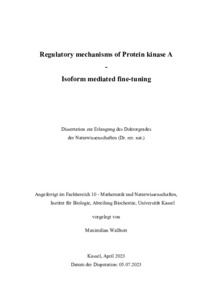| dcterms.abstract | cAMP-dependent protein kinase (PKA) is a crucial part in eukaryotic signal transduction and controls biological processes. With a multitude of substrates, a great variety of cellular functions are regulated by PKA. Regulation of metabolism, cell growth and -differentiation, conductivity of ion channels, movement of sperm cells, embryonic development, neuroplasticity as well as conversion of short- to long-term memory are just examples for the many tasks of the kinase. To achieve and coordinate these diverse functions, a precise spatiotemporal regulation of the kinase is essential. Various mechanisms have already been described for this fine-tuned regulation. However, after many years of PKA research, the interplay of the regulatory mechanisms is still not fully understood. In particular, the isoform diversity of PKA has been neglected. Therefore, this thesis aims to fill gaps in our understanding of PKA regulation, focusing on the poorly investigated PKA isoform RIβ and splice variants of Cβ.
Two distinct RIβ variants has been described in the past, with a residue variation at position 269. Here, the first comprehensive biochemical characterization of both variants is presented, identifying the canonical RIβ. Additionally, the data indicate that the canonical RIβ is more easily activated by cAMP in vitro than other R subunits. Monitoring of cAMP-induced holoenzyme dissociation in a time-dependent manner, revealed a reduced maximum dissociation for RIα/RIβ compared to RII subunits. This discovery is explained by liquid-liquid phase separation, a concept recently established for RIα. Finally, the characterization of engineered cyclonucleotide binding knockouts as well as pathogenic RIβ mutations provide insights in the holoenzyme activation and the cooperativity between the cyclonucleotide binding domains in the regulatory subunit.
Another aspect that gained only little attention so far in PKA research is the diversity of Cβ splice variants. Here, the first characterization of recombinantly expressed Cβ1, Cβ2, Cβ4 and Cβ4ab is conducted. The Cβ subunits only differ at their N-termini, yet the results identified altered kinase activity and KM values of peptide substrate and ATP. In cooperation with the University of California, San Diego, the first crystal structure of Cβ4ab was generated and is presented here. The structure highlights differences to PKA Cα, based on few distinct residues clustered in the N-terminal tail, C-terminal tail and the small lobe of the kinase important for nucleotide binding. Especially the latter may explain altered interactions of the Cβ splice variants with ATP, compared to Cα. This characterization may serve as starting point for further investigations, in particular regarding splice variant specific protein interactions. | eng |

